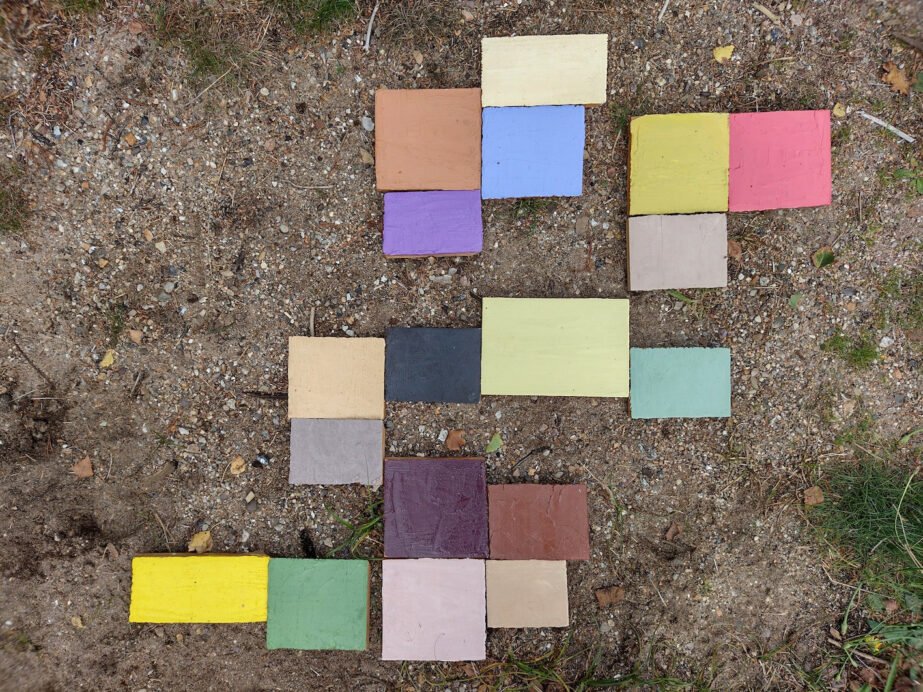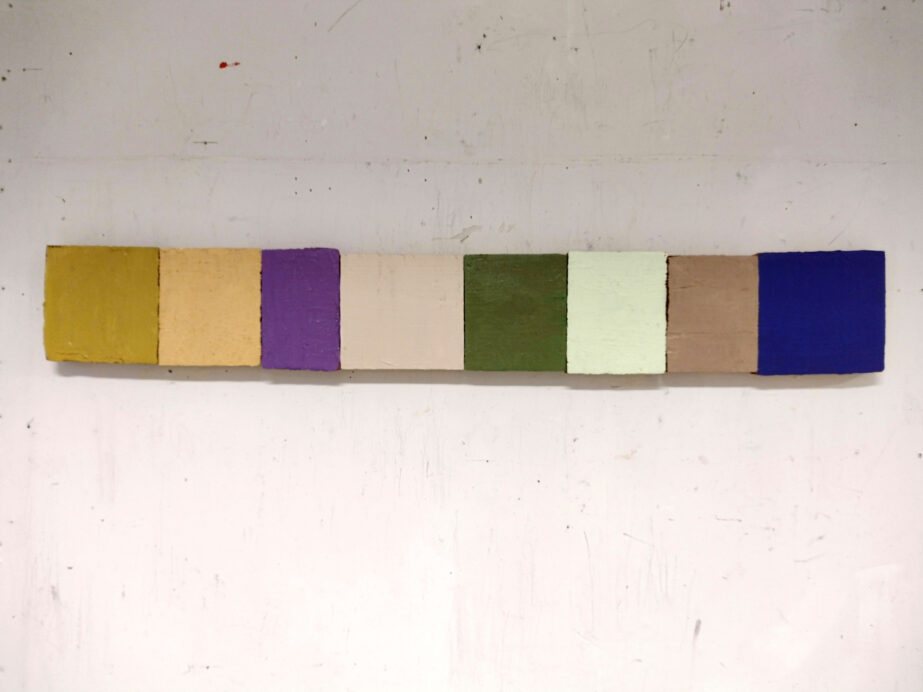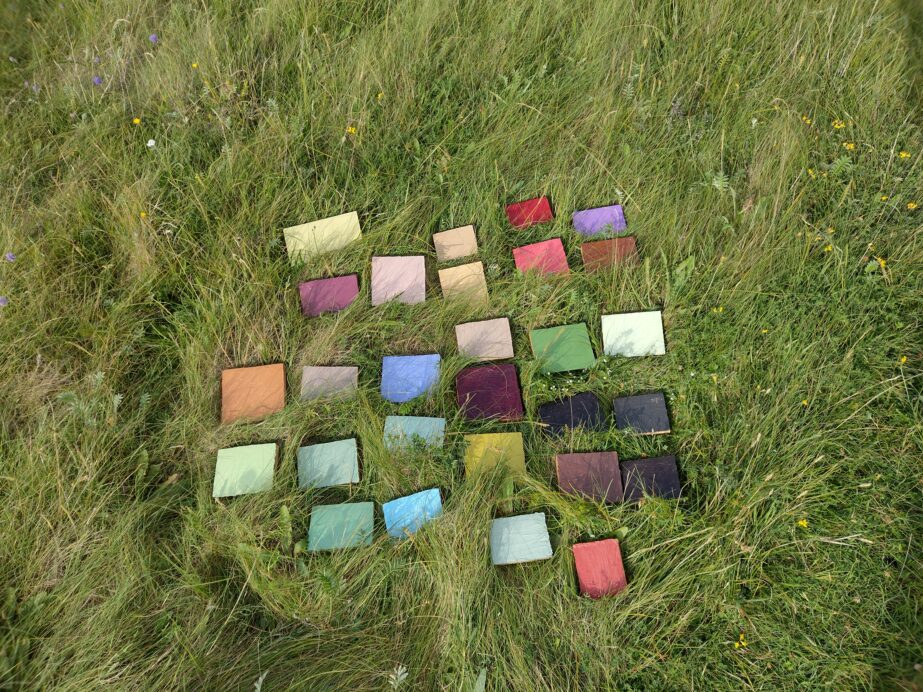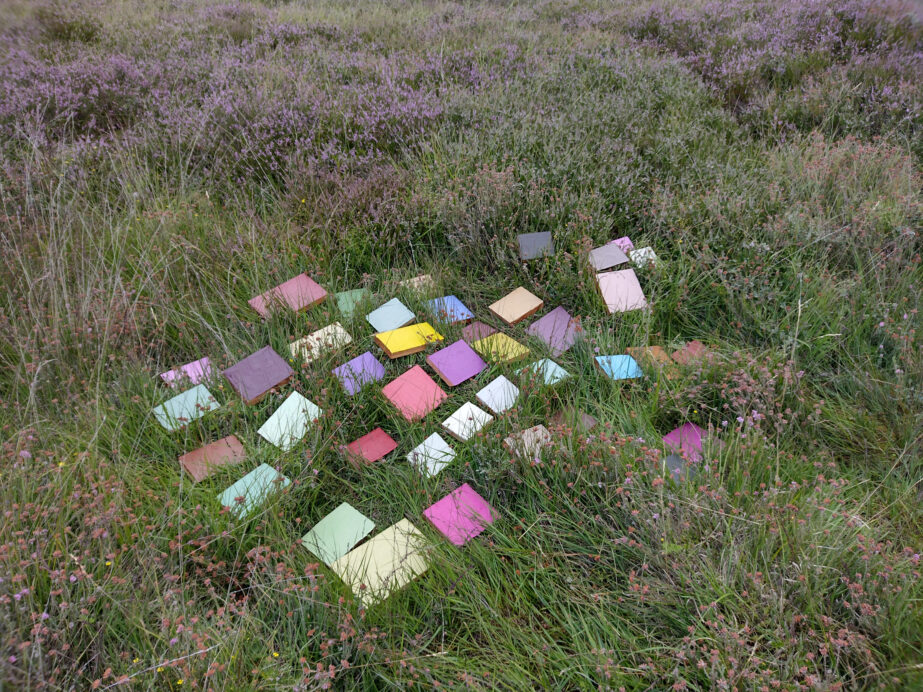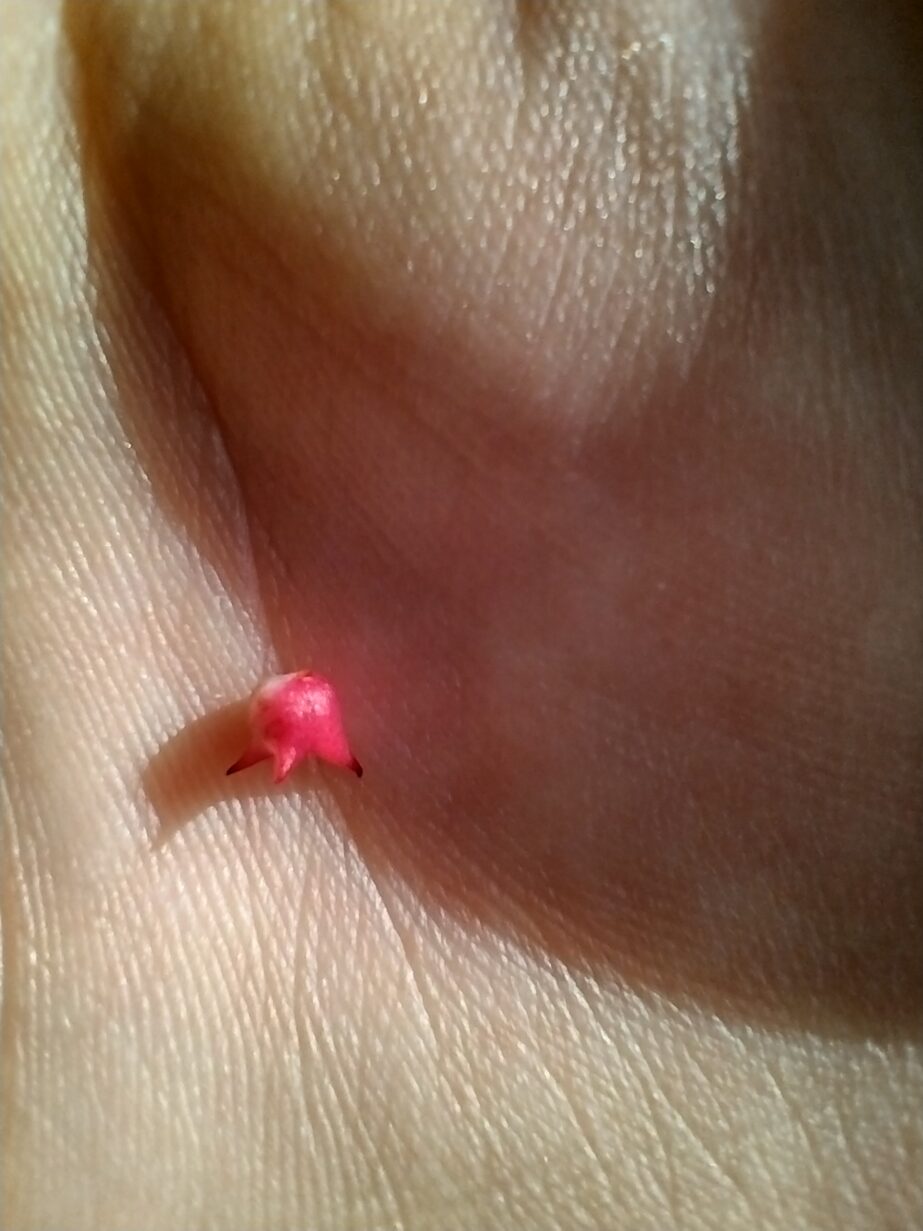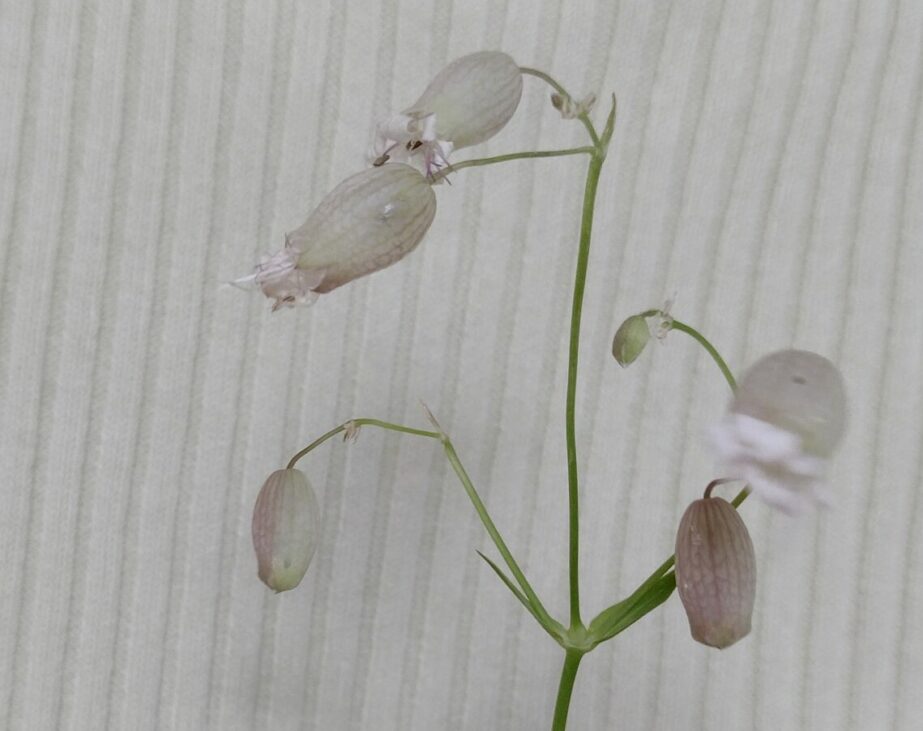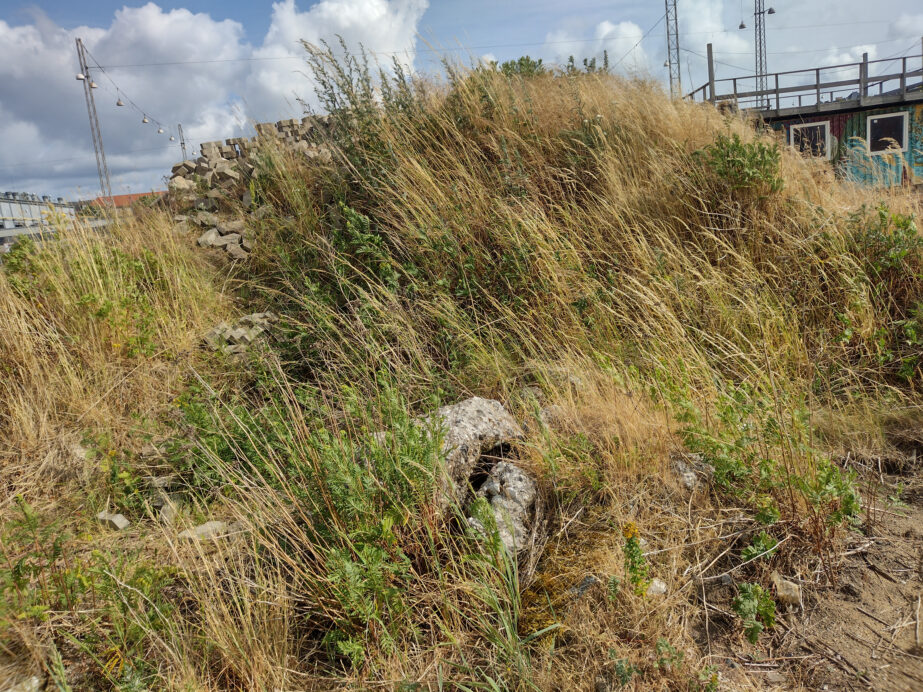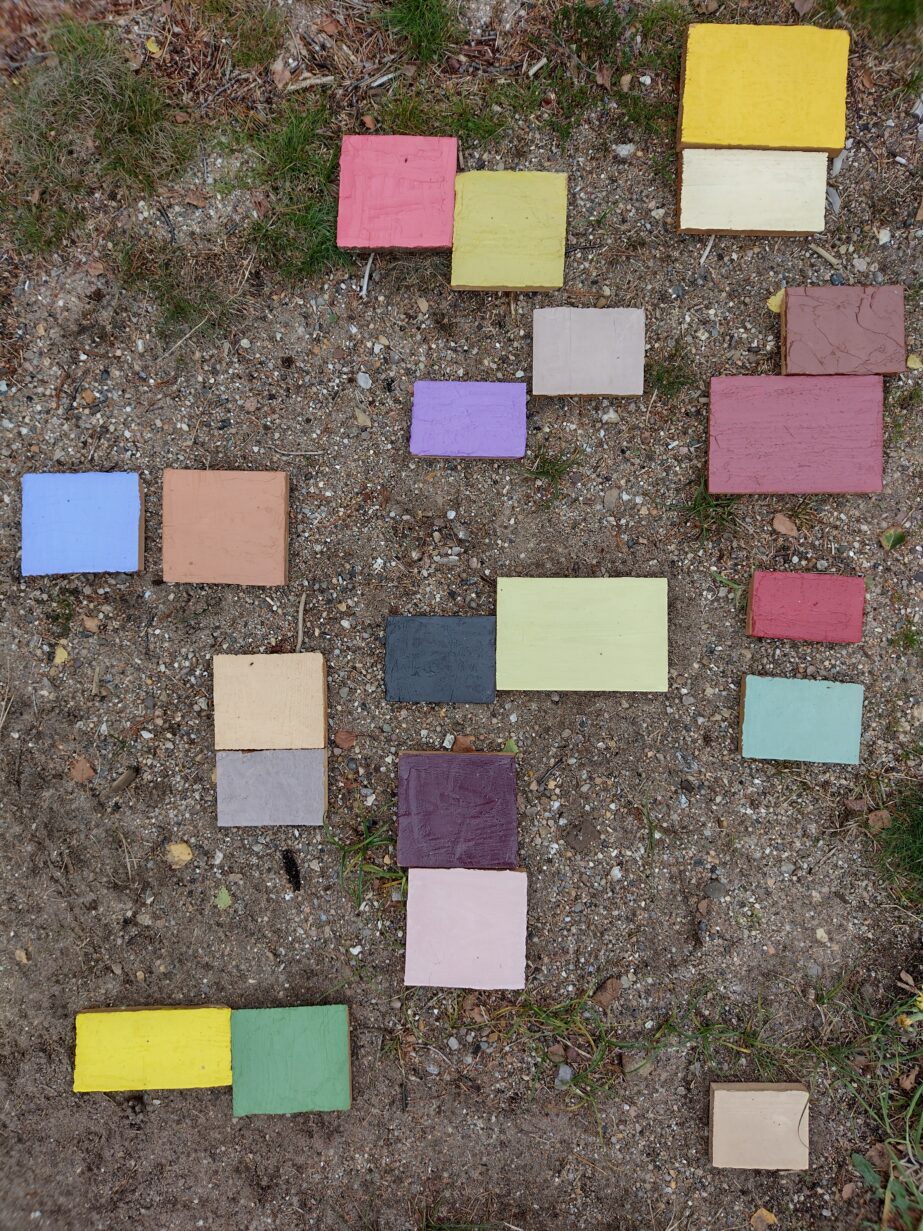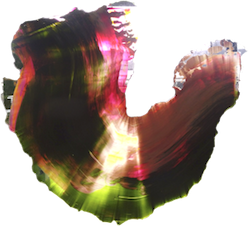Ekstrakt
Titel Ekstrakt
Sted
Aarhus
2024
Idé
Ekstrakt
et farve-nomenklatur
“Even our anxiety to obtain definite names for definite colors is completely overshadowed by the stronger wish to understand the secret of their harmonious relationship.”
Schuyler Matthews
fra Vanderpoel: Colorproblems
I kunstprojektet Ekstrakt arbejder vi med at “udtrække” farvenuancer fra et sted. Det vil sige, at vi arbejder med at blande nogle præcise farvetoner, som vi finder på de nærværende planter, rødder, insekter, sten, jordbund, nedbrudte plantedele på et udvalgt sted.
I Werner’s Nomenclature of Colours (1814)* relateres hver enkelt farvetone præcist til en plantedel, en fugl, et mineral, eksempelvis til den hvide farve på hættemågens brystfjer eller havtornens blomsts hvide farve.
Farvetonerne i Ekstrakt er på lignende måde hentet fra konkrete vækster o.a. hvor vi zoomer ind på detaljer og arbejder med at blande præcise nuancer.
Præcisionen i denne proces bygger på den øjeblikkelige sansning af farven. Når der zoomes ind, afslører der sig flere og flere variationer. Overfladen på eksempelvis planten Blæresmældes blomster, veksler tydeligt i detaljen mellem lys violet og grøn.
De observerede farvenuancer males på firkantede træklodser, lidt varierende i størrelse, omkring 2,5×15-20×15-20 cm med angivelse af kilde og måned bagpå: “Kragefod oktober”, “Musevikke juli”, “Gåsepotentil juni” osv.
Ved 6 pop-up udstillings-begivenheder placeres farvenuancerne på jordoverfladen, samme sted, som de er hentet fra, hvor de fremstår som en tilføjelse, et udtræk af farver, et koncentrat af stedet
Et slags klodset pixel-maleri, hvor farvetoner gennem årstidernes og vejrets skiften hentes op fra liv og vækster og jordbund på stedet.
Man kan måske sige at planter har en overlevelses-strategi. Denne strategi kan bero på farvens udstrålingskraft, hvor eksempelvis blomstens kronblades nuance har en særlig tiltrækningsevne i forhold til specifikke insekter. Andre strategier kan handle om måden hvorpå planten får sine frø spredt ud. Biodiversitetskrisen har blandt andet skærpet opmærksomheden på planters udbredelse og mangfoldighed.
Fokus i Ekstrakt er at udforske farvernes indbyrdes kraft. Forsøg med hvordan farvernuancer kan danne særegne rum og atmosfærer, blandt andet qua deres evne til at forstærke eller nedtone hinanden indbyrdes. Botanikken og iagttagelser af planternes koloristiske liv vil danne grundlag for en kunstnerisk undersøgelse.
Ekstrakt er et koloristisk anlagt farveeksperiment og samtidig en hyldest til arternes mangfoldighed og evne til at udfolde sig uventede steder.
For at holde styr på Ekstrakt´s observationer, laver vi noter for alle fundne arter og farvenuancer. Desuden uploader vi, som supplement til noterne, fotos og artsbestemmelser på sitet iNaturalist.org. Se mere her: https://www.inaturalist.org/pages/about – Et brugbart redskab, hvor observationerne i Ekstrakt indgår i en større sammenhæng.
Ikke så langt fra Ekstrakt´s demo-sted, på området bagved Godsbanen, blev der i 2020 botaniseret og fundet overraskende mange plantearter. (https://aarch.dk/vi-vil-bevare-godsbanens-vilde-arter/)
Farveklodserne kommer til at have nuancer fra vækster og jordbund som samles ind gennem hele året, efterår – vinter – forår – sommer. Vi vil arbejde med projektet fra efterår 2023 til efterår 2024. I løbet af denne periode vil vi afholde pop-up begivenheder på udvalgte steder. I første omgang fokuserer vi på Brabrandstien og på området bag Godsbanen. Herefter vil vi udvide radius og finde frem til andre steder i Aarhus, hvor floraen har kunnet udfolde sig. Et af stederne vil være Aarhus Å. Her vil vi trække farvenuancer ud fra brinken langs åen og selvfølgelig i vandet. Træklodserne vil flyde på åen.
Til den første demo-version af Ekstrakt har vi udvalgt en lille stribe bevoksning, som befinder sig mellem skateboard-banen og bueskytte-området. Der vil komme flere steder til efterhånden som projektet skrider fremad.
Til de botaniske undersøgelser og de endelige verificeringer af de noter, der knyttes til hver enkelt farvenuance, har vi allieret os med biologistuderende på AU, Sara Bjerrum
Et lille pilotprojekt udfoldes siden 2021 på øen Fur i Limfjorden. Her er stedet, som er hede og strandeng, af en markant anden karakter i forhold til farvenuancer i jordbund og fauna.
Artist Book Ekstrakt
Ekstrakt er et stedsspecifikt værk. Et maleri, som vokser ud af stedet, hvor det udfoldes. Når der er indsamlet tilstrækkeligt materiale, vil vi i samarbejde med kunstneren Maria Bruun udgive en artist-book hvor farveprojektet udfoldes grafisk. Artist Book Ekstrakt har disse arbejdstitler:
EKSTRAKT
– en guide
EKSTRAKT
– en brugsanvisning
EKSTRAKT
– om at lytte farver frem
Bogen løfter kunstprojektet fra det stedsspecifikke til en større udbredelse.
Via notater, fotos af steder, vækster og farvenuancer og farvesammensætninger gives kunstprojektets materiale og metode videre til nysgerrige læsere, som kan gå ud og selv forsøge sig med farvestudier og meditative sansninger af et sted.
Den franske forfatter Georges Perecs sociologi vender blikket mod de små ting. I den programmatiske tekst Tilnærmelser til hvad? (1973) beskriver han sin berømte teori om jagten på det ’infra-ordinære’, alt det, der er så almindeligt, at vi ikke lægger mærke til det: det modsatte af togulykker, flystyrt og andre af den slags ting, der udløser gule breaking news-bjælker på netaviserne. »Det, der i virkeligheden sker, det vi lever i, resten, alt resten, hvor er det henne?« spørger Perec »Det, der sker hver eneste dag, og som gentager sig hver eneste dag, det banale, det hverdagslige, det åbenlyse, det almene, det almindelige, det infra-ordinære, baggrundsstøjen, det vante, hvordan gør man rede for dét, hvordan stiller man spørgsmål til det, hvordan beskriver man det?«.
Udstilling
I Mellemrummet på Godsbanen vil vi i efteråret 2024 kombinere en præsentation af Artist Book Ekstrakt med en visning af materiale fra projektet.
Arbejdet med at blande præcise farvetoner er noget som ligger i logisk forlængelse af min (AMP) hidtidige praksis. I mange års arbejde med maleriet har eksperimenter med farvernes indbyrdes påvirkninger, lyset i farven, karakter, farvens udstrækning osv. spillet en dominerende rolle.
I Ekstrakt deltager:
Anne-Marie Pedersen, kunstner, Aarhus
Maria Bruun, kunstner og grafisk designer, København
Selma Krag, stud., kunstnerisk assistent, Aarhus
Sara Bjerrum, biologistud., AU
interesseret publikum
*Werners Nomenclature of Colours er en bog med navngivne farveprøver udarbejdet af Abraham Gottlob Werner og efterfølgende ændret af Patrick Syme. Bogen, der blev udgivet i 1814, blev brugt af Charles Darwin i hans videnskabelige observationer.
Title Extract
Idéa
Extract
A Color Nomenclature
“Even our anxiety to obtain definite names for definite colors is completely overshadowed by the stronger wish to understand the secret of their harmonious relationship.”
F. Schuyler Matthews
from Vanderpoel: Color Problems
In the art project Extract, we work on “extracting” shades of color from a location. This means that we blend specific color tones found on the nearby plants, roots, insects, stones, soil, and decomposed plant parts at a chosen location.
In Werner’s Nomenclature of Colours (1814)*, each color tone is precisely related to a part of a plant, a bird, a mineral, for example, the white color of the herring gull’s breast feather or the white color of sea buckthorn flowers.
The color tones in Extract are similarly derived from specific vegetation and other sources, where we zoom in on details and work on blending precise shades. The precision in this process is based on the immediate perception of color. When zoomed in, more and more variations are revealed. For instance, the surface of a bladder campion flower clearly shifts between light violet and green in detail.
The observed color tones are painted on square wooden blocks, slightly varying in size, around 2.5×15-20×15-20 cm, with the source and month indicated on the back: “Jackdaw’s Foot October,” “Bush Vetch July,” “Cinquefoil June,” etc.
During six pop-up exhibition events, the color tones are placed on the ground at the same location where they were collected, appearing as an addition, an extract of colors, a concentrate of the place, a sort of clumsy pixel painting, where color tones are drawn from the life, growth, and soil of the location through the seasons and weather changes.
One could argue that plants have a survival strategy. This strategy can rely on the radiance of color, where, for example, the hue of a flower’s petals has a special attraction for specific insects. Other strategies may concern how the plant disperses its seeds. The biodiversity crisis has, among other things, sharpened attention on the distribution and diversity of plants.
The focus in Extract is to explore the power of colors among each other. Experiments with how color tones can create unique spaces and atmospheres, partly through their ability to enhance or tone down each other. Botany and observations of the chromatic life of plants will form the basis for an artistic investigation.
Extract is a chromatically oriented color experiment and, at the same time, a tribute to the diversity of species and their ability to thrive in unexpected places.
To keep track of Extract’s observations, we make notes for all found species and color tones. In addition, we upload photos and species identifications to the iNaturalist.org website as a supplement to the notes. See more here: https://www.inaturalist.org/pages/about – A useful tool where Extract’s observations become part of a larger context.
Not far from Extract’s demo site, in the area behind Godsbanen, botanists in 2020 found a surprisingly large number of plant species. (https://aarch.dk/vi-vil-bevare-godsbanens-vilde-arter/)
The color blocks will contain shades from vegetation and soil collected throughout the year, autumn – winter – spring – summer. We will work on the project from autumn 2023 to autumn 2024. During this period, we will hold pop-up events at selected locations. Initially, we focus on Brabrandstien and the area behind Godsbanen. Afterward, we will expand our radius and discover other places in Aarhus where flora has been able to flourish. One of these places will be Aarhus River. Here, we will extract color tones from the riverbank and, of course, from the water. The wooden blocks will float on the river.
For the first demo version of Extract, we have chosen a small strip of vegetation located between the skateboard park and the archery area. More locations will be added as the project progresses.
For botanical studies and the final verification of the notes related to each color tone, we have collaborated with biology students at AU, Sara Bjerrum.
A small pilot project has been unfolding since 2021 on Fur Island in Limfjorden. The location, a heath and coastal meadow, has significantly different characteristics in terms of color tones in soil and fauna.
**Artist Book Extract**
Extract is a site-specific work. A painting that grows out of the place where it unfolds. When enough material has been collected, we will collaborate with the artist Maria Bruun to publish an artist book where the color project is presented graphically. Artist Book Extract has the following working titles:
EXTRACT
– A Guide
EXTRACT
– An Instruction Manual
EXTRACT
– Listening Colors Out
The book elevates the art project from the site-specific to a broader dissemination. Through notes, photos of locations, vegetation and color tones, and color combinations, the art project’s material and method are passed on to curious readers who can go out and experiment with color studies and meditative sensory experiences of a place.
The French author Georges Perec’s sociology turns its gaze to the small things. In his programmatic text “Approaches to What?” (1973), he describes his famous theory about the pursuit of the “infra-ordinary,” all that is so common that we don’t notice it: the opposite of train accidents, plane crashes, and other such events that trigger breaking news alerts in online newspapers. “What really happens, what we live, what we do each day, the rest, everything else, where is it?” Perec asks. “What happens every day, what repeats itself every day, the mundane, the everyday, the obvious, the common, the ordinary, the infra-ordinary, background noise, the familiar, how do you account for that, how do you question it, how do you describe it?”
**Exhibition**
In the Mellemrummet at Godsbanen, in the autumn of 2024, we will combine a presentation of the Artist Book Extract with a display of materials from the project.
The work of blending precise color tones is a logical extension of my (AMP) previous practice. In many years of working with painting, experiments with the interactions of colors, the light in color, character, the extent of color, etc., have played a dominant role.
Participants in Extract:
Anne-Marie Pedersen, artist, Aarhus
Maria Bruun, artist and graphic designer, Copenhagen
Selma Krag, student, artistic assistant, Aarhus
Sara Bjerrum, biology student, AU
Interested audience
*Werner’s Nomenclature of Colours is a book of named color samples compiled by Abraham Gottlob Werner and subsequently modified by Patrick Syme. The book, published in 1814, was used by Charles Darwin in his scientific observations.
